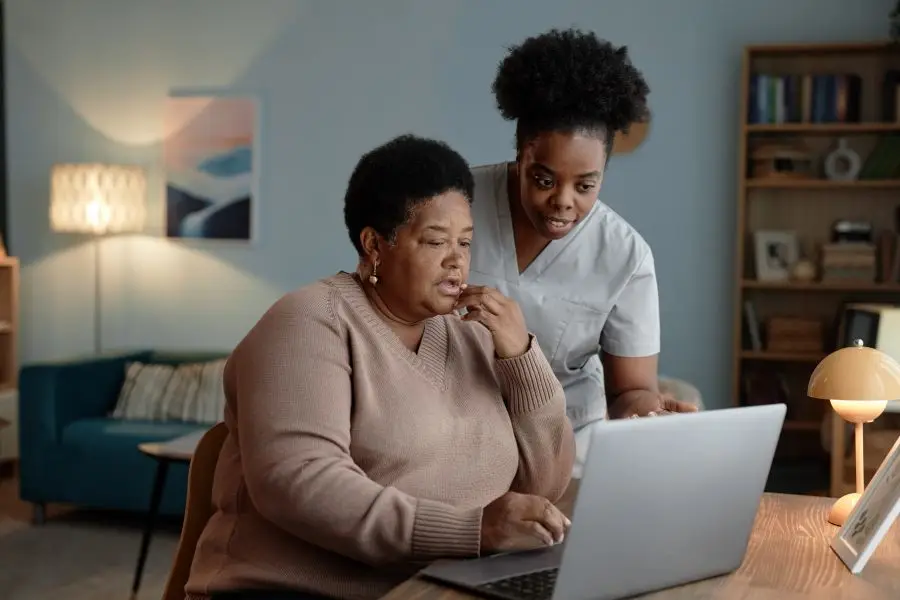TL;DR
An accessible home care website design isn’t just good ethics, it’s a competitive advantage. From improving Google rankings to converting more family caregivers into booked consultations, accessible, HIPAA-conscious websites help home health agencies attract more local patients, faster, safer, and more reliably.
Key Highlights
- 97% of healthcare websites fail basic accessibility audits (WebAIM)
- 82% of local care searches happen on mobile, accessibility = conversion
- Accessible design boosts Google Core Web Vitals and local SEO visibility
- ADA & HIPAA compliance protects against lawsuits and builds trust
- Seniors and family caregivers engage longer with accessible, user-friendly design
- One agency saw a 3X increase in patient inquiries after accessible redesign
- Accessibility improves conversion rates, bounce rate, and ranking signals
- Accessible websites = digital front doors that welcome more patients

Table of Contents
ToggleIn the fast-changing world of digital patient acquisition, your website is no longer just a brochure, it’s your primary gateway to care. And if your home health agency’s website isn’t accessible, you’re not just missing conversions, you’re excluding the very families who need you most.
Today’s families are searching for local providers on mobile, often in high-stress moments. They need quick answers, easy navigation, and trust at first glance. Yet, a staggering 97% of healthcare websites don’t meet basic accessibility standards, according to WebAIM’s accessibility report. That means the majority of agencies are invisible, or unusable for seniors with vision loss, caregivers using screen readers, and anyone searching on mobile.
At Home Health Web, we’ve spent decades helping home health providers grow ethically, sustainably, and measurably. We built The Compassionate LocalCare Marketing System to address the core digital challenges home care agencies face: visibility, compliance, conversion, and trust. Through that lens, this article breaks down 10 reasons accessible home care website design directly improves patient acquisition, and how your agency can lead locally by designing with empathy, performance, and privacy in mind.
Whether you’re an agency owner tired of being outranked by generic competitors, or a marketing director looking for a HIPAA-safe, patient-first digital strategy, you’re in the right place.
Let’s unlock what accessible design can do for your growth.
What Do We Mean by “Accessible Home Care Website Design”?
Accessible design goes far beyond “looking good.” It ensures your website is usable for seniors with vision loss, adult children searching on mobile, and users relying on screen readers or keyboard-only navigation.
According to ADA.gov’s guide on website accessibility, businesses, including home health agencies must make their online services accessible under the Americans with Disabilities Act (ADA). This includes ensuring content is perceivable, operable, understandable, and robust for all users, regardless of ability. It includes:
- ADA-compliant design and navigation
- Mobile-first responsiveness
- Clear contrast and readable fonts
- Voice-reader compatibility
- HIPAA-compliant forms
In other words, it ensures your site is easy to find, easy to use, and easy to trust.
The Risk of Ignoring Accessibility
- 97% of healthcare websites fail basic accessibility tests
- 70% of users will leave a site if it’s slow or unreadable on mobile
- Non-compliant websites face legal risk under the ADA and HIPAA
Every frustrated user is a missed patient.
Now, let’s walk through the 10 reasons why getting this right can transform your agency’s growth.
1. Builds Trust with Family Caregivers Instantly
When families are in crisis, they’re searching for a provider who feels professional and compassionate from the first click. A cluttered, confusing website sends the wrong message.
Accessible design creates calm. It shows attention to detail, care for users, and readiness to help.
“We were overwhelmed. But this site made it simple to understand the services, and we booked a consultation immediately.” – Daughter of a new patient
2. Drives More Conversions from Local Searches
In home health care, the competition for visibility in local search results is fierce, and it’s only getting harder.
Families searching “home care near me” or “nurse for mom in [city]” are often comparing 3 to 5 local providers before they ever make a call. If your agency’s website isn’t accessible and optimized for local search intent, you’re already behind.
Here’s the good news: accessible websites don’t just help users, they help Google help users. In fact, accessibility improvements often overlap directly with the factors that Google rewards in local SEO:
Accessibility-Driven SEO Wins:
- Clean site structure & semantic HTML = Better indexability
- Fast load times and responsive design = Higher Core Web Vitals scores
- Readable content with descriptive headings = Higher relevance and engagement
- Image alt text and ARIA labels = Enhanced visibility for voice and AI search
- Mobile usability = Stronger rankings in Google’s mobile-first indexing system
But visibility is just the beginning. Conversion happens when users trust you enough to act.
When your site is accessible, families:
- Find your business faster in Google Maps and local listings
- Understand your services immediately without frustration
- Feel confident clicking “Request Care” because the page loads fast and looks secure
- Trust that your agency is professional and detail-oriented
A recent update to Google’s algorithm even favors local providers with well-optimized, trustworthy websites, especially in service-based industries like home care. That’s exactly why we incorporate technical SEO, accessibility audits, and emotional design principles into our Local SEO Services for Home Care Providers.

Fun Fact About Accessible Home Care Website Design:
According to Google, 76% of people who search for something nearby on their smartphone visit a related business within 24 hours, and 28% of those searches result in a purchase or service booking.
For home health agencies, that “purchase” could mean a family choosing your care over a competitor’s, simply because your website made the process easier and more human.
Google rewards fast, mobile-friendly, ADA-compliant websites with higher rankings in local search results, especially with the rollout of Core Web Vitals and AI-powered search features.
That means accessibility isn’t just ethical. It’s profitable.
Our Local SEO Services for Home Care Providers are specifically built around this principle.
3. Ensures ADA Compliance & Reduces Legal Risk
Accessibility isn’t just ethical, it’s legally required. Over the past few years, hundreds of healthcare providers have faced lawsuits due to non-compliant websites that prevented users with disabilities from navigating or filling out forms.
The WebAIM WCAG Checklist offers a practical breakdown of the Web Content Accessibility Guidelines (WCAG), which serve as the standard for digital accessibility.
Ensuring your website meets WCAG criteria minimizes the risk of legal action, builds public trust, and shows a commitment to inclusive care.
An ADA-compliant website protects your agency and empowers all patients, regardless of ability.
Real risk: Non-compliant forms, missing alt text, or poor contrast can result in fines upwards of $50,000+ and serious PR damage.
4. Boosts SEO Through Better Core Web Vitals
Google’s search algorithms have shifted dramatically. Search engine optimization is no longer just about keywords. It’s 100% about user experience. Sites that meet accessibility standards often naturally perform better in Google’s Core Web Vitals, which measure speed, visual stability, and interactivity.
These are now confirmed ranking signals. Learn more about how these metrics work and why they matter at Google’s Core Web Vitals resource. When accessibility and SEO converge, your agency shows up higher in search, and families find you faster.
- Faster load times = higher patient satisfaction
- Mobile optimization = better rankings
- Intuitive structure = lower bounce rates
And since SEO is one of the best long-term strategies for growth, your accessible website becomes a lead-generating asset. Not just a digital brochure.
5. Supports Seniors with Visual & Cognitive Challenges
Your audience isn’t just millennials researching options for their parents. Many seniors themselves visit your website, or depend on their adult children who may be overwhelmed and making fast decisions under pressure. If your site is cluttered, hard to read, or confusing to navigate, it becomes a barrier to care.
Accessible home care websites address this with:
- Readable font sizes (16px+ for body text)
- High color contrast (to aid users with macular degeneration or cataracts)
- Simple layouts with predictable navigation (especially helpful for users with early-stage dementia or cognitive delays)
- Keyboard-friendly functionality for users with mobility impairments or tremors
The emotional benefit? Families see your website and immediately feel relief: “Finally, someone who understands what we’re going through.”
This attention to accessibility isn’t just a checkbox, it’s a digital extension of your compassionate, hands-on care philosophy. By showing that your agency anticipates and adapts to seniors’ real-world needs, you’re demonstrating empathy before you even pick up the phone.
6. Strengthens HIPAA-Conscious Lead Capture
Accessibility and compliance go hand-in-hand.
Secure, clearly labeled forms with privacy indicators build confidence. When paired with HIPAA-Compliant Lead Capture Strategies, you create an experience where families feel safe sharing their story, and their data.
Families won’t fill out online forms if they look untrustworthy or worse, expose them to risk. Your website must balance ease-of-use with airtight security, ensuring that patient data is collected and stored in a HIPAA-compliant way.
According to the Health Insurance Portability and Accountability Act (HIPAA), agencies must implement safeguards such as SSL encryption, secure web hosting, Business Associate Agreements (BAAs), and clear privacy policies. These aren’t just technical add-ons, they’re trust signals that directly impact conversion rates.
Bonus: HIPAA-conscious sites load SSL certificates faster, boosting both SEO and user trust.
7. Improves Mobile Usability for On-the-Go Families
Imagine this: A daughter is sitting in her car, just after leaving the hospital with her elderly mother. She’s overwhelmed, Googling “home care near me” on her phone. What happens next depends entirely on your website.
If your site loads slowly, isn’t readable on mobile, or forces her to pinch, zoom, and scroll, she’ll likely hit “back” and choose the next provider on the list.
Mobile-first usability isn’t just about convenience, it’s about conversion.
In today’s digital landscape, over 82% of local healthcare searches happen on mobile devices. For home health care, that percentage is even higher among caregivers who are researching options between errands, appointments, and work shifts.
If your website isn’t built for small screens, you’re losing the attention, and the trust of these high-intent users.
Accessible home care websites are designed with mobile-first accessibility in mind, including:
- Tap-friendly buttons with enough space to avoid accidental clicks
- Clear CTAs (“Request Care,” “Book Now”) above the fold for faster engagement
- Responsive layouts that adjust seamlessly across phones, tablets, and assistive browsers
- Fast-loading pages under 3 seconds to meet Google’s mobile performance benchmarks
- Simple forms that don’t require excessive typing or complicated dropdowns
These elements don’t just improve user experience, they directly increase your agency’s conversion rates, reduce bounce rates, and help your site rank better in mobile-first indexing by search engines like Google.
“I was looking for care between shifts at work, your site was the only one that made it easy on my phone.” – Actual user testimonial (caregiver, Florida)
And from an emotional perspective, mobile accessibility tells families:
“We’ve thought about your needs. We respect your time. We’re ready to help, whenever and wherever you need us.”
8. Differentiates You from Bigger Competitors
Many large healthcare systems still rely on outdated, overly clinical websites.
Your agency has the chance to stand out by being more personal, more modern, and more empathetic online.
Accessible design shows you’re not just another provider, you’re a partner in care.
Pair that with our insights from AI Search & the Future of Home Health Care Marketing, and you’ll see how small agencies are dominating local SERPs.
Remember, large healthcare systems often dominate the digital space with big marketing budgets and generic messaging. But their websites? Often cold. Clunky. Impersonal.
That’s your opportunity.
With accessible website design, you position your home care agency as a compassionate, patient-first alternative. One that doesn’t just offer services, but understands the urgency and emotion behind the search.
By showing empathy in your online presence through clean layouts, thoughtful messaging, and accessible features, you build connection before the first conversation.
And while many larger providers overlook the nuances of compliance and accessibility, your agency can stand out by getting both right from the start.
If you want to ensure your website builds trust and protects patient privacy, this guide on Why Your Home Health Agency Needs a HIPAA-Compliant Website Now breaks down what’s at stake, and how to fix it fast.
9. Increases Time-on-Site & Reduces Bounce Rate
When users can navigate your site with ease, they stay longer, click deeper, and are more likely to engage.
That’s not just good UX, it’s smart marketing.
Google rewards websites that provide value and keep users engaged, and accessibility plays a critical role in this.
When your website is accessible:
- Pages load quickly and display correctly across all devices.
- Visitors can easily scan and understand content, especially when using screen readers or assistive technology.
- Forms and buttons are clearly labeled and intuitive to use, reducing confusion.
- Navigation is logical and seamless, encouraging visitors to explore multiple service pages, testimonials, or blog posts.
Google tracks these behaviors as ranking signals. A sticky site with high engagement outperforms clunky competitors every time.
This creates a positive user experience, which directly improves:
- Time-on-site (a key engagement metric in SEO)
- Bounce rate (the percentage of users who leave after only viewing one page)
In practical terms, a visitor who might have left after 10 seconds stays for 3–5 minutes instead. They read about your services, check reviews, and ultimately click Request a Consultation.
Accessible websites don’t just serve users with disabilities, they serve every user better.

10. Future Proof Your Brand for Search & Accessibility Standards
Digital standards are evolving quickly with AI, voice search, and personalization at the forefront.
Accessible design ensures your agency is ready for:
- AI-generated search previews
- Voice-assisted inquiries
- Enhanced semantic markup (for Google and Bing bots)
Accessibility isn’t a one-time checkbox, it’s a strategy to remain relevant in the evolving digital landscape.
As AI tools like Google’s Search Generative Experience (SGE) and voice-based search grow more common, websites with semantic structure, alt-text, fast load times, and clean navigation will dominate results.
Accessible design ensures your agency can be surfaced in next-gen search interfaces, voice assistants, and even screenless experiences, keeping your care available wherever families are looking. For a foundational understanding, revisit the ADA.gov accessibility overview to futureproof your presence now.
Your website becomes a trusted guide for families in need, not a digital dead-end.
How One Accessible Website Tripled Patient Leads
Before:
A mid-sized agency in northern New Jersey had a reputation for compassionate, high-quality care. But their website told a different story. It was outdated, hard to navigate on mobile, and loaded slowly. The font was small, the forms were clunky, and the site wasn’t ADA or HIPAA compliant.
Worse? Local competitors with bigger budgets were outranking them in Google, despite having lower patient satisfaction scores.
Their intake coordinator shared this frustration:
“We knew families were searching for us online, but we’d get calls saying, ‘We couldn’t find your services clearly,’ or ‘Your site wasn’t working on my phone, so we just called someone else.’”
They were losing patients. Not because of their care, but because of their digital first impression.
The Turning Point:
After partnering with our team to rebuild their site using The Compassionate LocalCare Marketing System Overview, We applied a patient-first, accessibility-forward approach that included:
- ADA-compliant navigation and proper semantic structure
- Mobile-first layout with large, readable fonts and high-contrast color schemes
- Screen-reader compatibility and keyboard-friendly interface
- HIPAA-compliant lead forms with clear privacy messaging
- Local SEO optimization with targeted zip-code landing pages
- Emotionally intelligent copy that spoke directly to family caregivers in crisis
We didn’t just give them a “prettier” site, we gave them a digital care experience that matched their real-world values.
The Results (90 Days Post-Launch):
- 3X increase in qualified patient inquiries
- 62% boost in booked in-home assessments
- Top 3 Google ranking for 11 local keywords
- Family feedback praising site clarity and ease-of-use
One caregiver who found them post-redesign said:
“Your website was the first one that felt like someone understood what I was going through. I showed my mom the services on my tablet, and we booked a nurse that afternoon.”
This isn’t just a win in metrics, it’s a win in mission. Because when a home care website is accessible, secure, and emotionally supportive, it turns uncertainty into action, and clicks into care.
Closing the Gap Between Trust & Technology
If your website isn’t accessible, your care may never reach the people who need it most. Today’s families expect digital clarity before they ever make a phone call.
Your website should make them feel heard, seen, and supported.
It’s Time to Upgrade More Than Just Design
“The next 5 families searching for care in your area could be yours, if your site is ready to welcome them.”
That’s where we come in.
At Home Health Web, we combine empathetic messaging, HIPAA-conscious lead capture, and hyper-local SEO into a strategy that converts browsers into booked patients.
Let us audit your current site for accessibility, compliance, and conversion, free and 100% confidential.
Book Your Visibility Audit Now →
Let’s make your website work for the people who matter most, your patients and their families.



